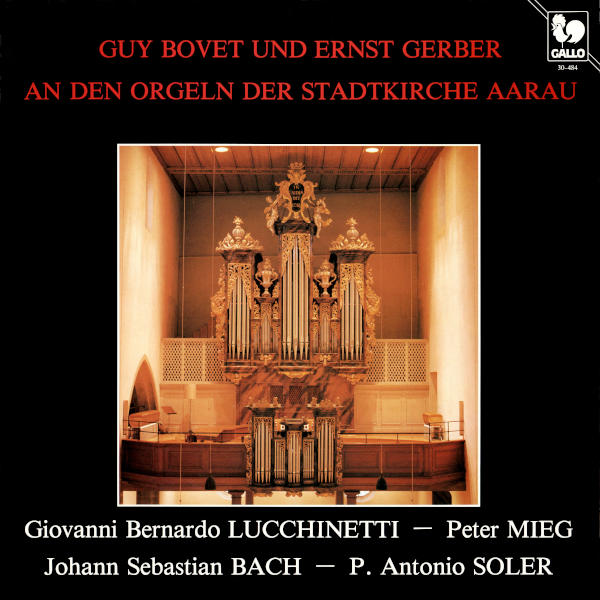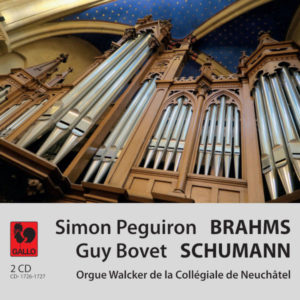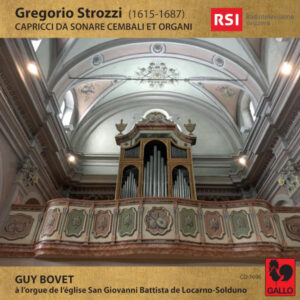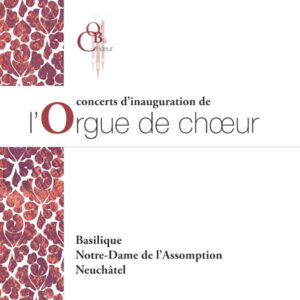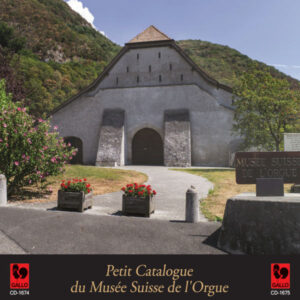Extraits / Excerpts
Lucchinetti - Mieg - Bach - Soler: Works for Two Organs - Guy Bovet, Ernst Gerber at the Organs of the Stadtkirche of Aarau
Guy Bovet, Ernst Gerber at the Organs of the Stadtkirche Aarau
Giovanni Bernardo LUCCHINETTI: Concerto a due Organi: I. Spiritoso – II. Allegro – Peter MIEG: Rencontres pour deux Orgues: I. Alla breve – II. Adagio – III. Gigue agitée – Johann Sebastian BACH: Concerto for 2 Harpsichords in C Major, BWV 1061: I. Without Indication – II. Adagio ovvero – III. Largo – Fuga – Antonio SOLER: Concierto No. 1 de dos Organos Obligados: I. Andante – II. Minué.
Music for Two Organs
Historical Background
There are churches in Italy, Spain and Southern Germany, dating back to the 15th century, where it is possible to play two or more organs, a practice corresponding to polychoral tradition.
If the instruments were placed at some distance from each other, one obtained some fascinating stereophonic effects, reflected back by the acoustics and architecture of the building.
But the organs are often situated on either side of the choir, which allowed the organists to see each other and to perform with greater precision.
The 18th Century Repertoire
The 18th century produced most of the literature written for two organs, but which was also played on a wide variety of instruments: church organs, choir-organs, harpsichords, clavichords, pianofortes, harps, etc.
But the contrasting styles of playing the organ allow the music to take on greater variety; another fascinating effect is produced by the combination of organ-pipes and stringed instrument.
The Organs of Aarau’s Stadtkirche
The possibility of playing two organs has long existed in Aarau’s Stadtkirche.
On the main organ-loft is the grand organ with four manuals, made in 1963 from a magnificent Speisegger case dating from 1756, year of Mozart’s birth.
Directly opposite, above the choir, a new organ made in 1983 has replaced an older instrument kept in almost the same place.
The two organs are the work of Kuhn in Männedorf/Zurich, were voiced by Kurt Baumann and have mechanical traction.
The Works
Lucchinetti’s Concerto has all the characteristics of a classical piece for two organs: it is concerted, sometimes in alternation, sometimes simultaneously, using the effects produced by the distance between the instruments.
Peter Mieg wrote his «Rencontres» for the inauguration of the new choir organ.
The composer had been inspired by several concerts featuring two organs given in this same church over the past years.
His piece also begins in highly classical tradition, but he then amuses himself by bringing the responses closer and closer together until they become simultaneous — a venture that presents some problems when the distance between the instruments is great and visual contact impossible.
It is lucky that there is a contemporary work for two organs to accommodate the instruments’ entire sound range.
Bach added an orchestral part (often in unison with the harpsichords) to his Concerto in C major only as an afterthought, and only for the 1st and 3rd movements.
Forkel, Bach’s first biographer, writes:
‘It can be played without the strings, and still sound highly effective’.
The juxtaposition of organ and harpsichord emphasizes the elaborate counterpoint and dialogic relief.
Soler’s Conciertos, composed to instruct the infante Don Felipe de Bourbon, were written for an instrument with two keyboards facing each other, so that there was close visual contact between the two players.
That is why it was decided here to play this piece on two keyboards belonging to the same organ.
- Categories
- Composers
- Interprets
- Booklet
